News (799)
Children categories
ES! Initiatives (74)
EarthSolidarity!™ Initiatives are endeavors to which anyone can contribute in deed as well as in spirit, that
- minimize waste and environmental impacts
- increase community resilience
- respect and protect ecosystem processes and all forms of life
- contribute to good living conditions for everyone around the globe
- affirm and celebrate our interdependence and interrelatedness in the Web of Life!
ORNL engineering eco-friendly solvents
 ORNL researchers are using artificial intelligence to speed the identification of environmentally friendly solvents for industrial applications. Andy Sproles/ORNL, U.S. Department of Energy
ORNL researchers are using artificial intelligence to speed the identification of environmentally friendly solvents for industrial applications. Andy Sproles/ORNL, U.S. Department of Energy
OAK RIDGE — Oak Ridge National Laboratory scientists developed a method leveraging artificial intelligence to accelerate the identification of environmentally friendly solvents for industrial carbon capture, biomass processing, rechargeable batteries and other applications.
The research targets a class of solvents known for being nontoxic, biodegradable, highly stable, cost-effective and reusable.
The scientists developed a method to predict solvent viscosity — a key property impacting performance for industrial applications. They compiled nearly 5,000 data points on 672 solvents, evaluated quantum chemical features that guide solvent molecular interactions, and deployed an algorithm called categorical boosting to quickly parse the data and determine the best candidates.
“We reduced computational time and complexity with our approach, while still incorporating all possible molecular interactions,” said ORNL’s Mohan Mood.
ORNL’s Michelle Kidder said, “Interpretable machine learning helps us to design solvents with desired properties for carbon capture by reducing experimental time and cost in the laboratory.”
Gather Under One Canopy at Tennessee Urban Forestry Council conference
Written by Thomas Fraser
NASHVILLE — The annual Tennessee Urban Forestry Council conference is set for Nov. 14-15 at the Scarritt Bennett Center.
This year’s theme is Under One Canopy, which will highlight how individuals, organizations and municipalities are engaging with diverse stakeholders and cross-sector partners to make an impact in Tennessee communities through urban forestry. Confrence attendees will celebrate achievements from across the state, exchange ideas and learn from the latest urban forestry studies and stories.
Full registration and lodging details will be announced soon.
Harpeth Conservancy fundraiser comes with dinner in a creek


KINGSTON SPRINGS — The 2024 Dinner IN the Creek, a fundraiser for the Harpeth Conservancy, will be nestled in the serene beauty of Bell’s Reserve in Kingston Springs. This hidden oasis, with over a mile of Harpeth River waterfront, offers a unique setting for the event in a charming spring-fed creek at the heart of the 600-acre property.
This year’s Dinner IN the Creek, sponsored by Amazon, is set for 6-9 p.m. July 23. Tickets are $500 and include a Hispanic-roots dinner from renowned chefs and live entertainment from Brother and the Hayes.
Harpeth Conservancy’s vision is clean water and healthy ecosystems for rivers in Tennessee championed by the people who live here.
 An area of high pressure lingered in the upper atmosphere over the U.S. Midwest and Northeast in June 2024. This pushed warm air toward the surface and trapped it there—a weather phenomenon meteorologists call a heat dome. The heat wave reached the Southern Appalachians, as seen in this model generated from NASA Earth Observatory data. NASA
An area of high pressure lingered in the upper atmosphere over the U.S. Midwest and Northeast in June 2024. This pushed warm air toward the surface and trapped it there—a weather phenomenon meteorologists call a heat dome. The heat wave reached the Southern Appalachians, as seen in this model generated from NASA Earth Observatory data. NASA
How climate change is heating up the weather, and what we can do about it
This article was originally published by The Conversation.
The heat wave that left more than 100 million people sweating across the eastern U.S. in June 2024 hit so fast and was so extreme that forecasters warned a flash drought could follow across wide parts of the region.
Prolonged high temperatures can quickly dry soils, triggering a rapid onset drought that can affect agriculture, water resources and energy supplies. Many regions under the June heat dome quickly developed abnormally dry conditions.
(The average temperature of June was about 7 degrees above normal in Knoxville as reported by Weather Underground).
The human impacts of the heat wave have also been widespread. In Ohio and Pennsylvania, emergency room visits for heat-related illnesses surged. Several Massachusetts schools without air conditioning closed to protect kids and teachers. In New York and New Jersey, electric wires sagged in the heat, shutting down trains into and out of New York City and leaving commuters stranded.
- flash drought
- june heatwave
- heat and public health
- impacts of extreme heat
- solutions to extreme heat
- heat deaths
- drought
- climate connection to heat
- renewable energy
- air conditioning
- coping with extreme heat
- science of heat
- climate change heat
- climate change sociology
- home cooling
- jeffrey basara
- mathew barlow
- umass lowell climate science
Big South Fork volunteers honor natural heritage, national trails
Written by National Park Service Volunteers helped build this bridge on Sheltowee Trace in Big South Fork National River and Recreation Area. National Park Service
Volunteers helped build this bridge on Sheltowee Trace in Big South Fork National River and Recreation Area. National Park Service
ONEIDA — Two popular trails were greatly improved with the help of volunteers during Big South Fork’s annual National Trails Day event, observed this year on June 22.
Volunteers helped build a 40-foot-long trail bridge between Yahoo Falls and Alum Ford on the Sheltowee Trace (a designated National Recreation Trail), by assisting park staff in transporting lumber and tools as well as the replacement of decking boards and handrails on the entire bridge. Volunteers also assisted trail crews with vegetation, drainage and tread improvements on the Proctor Ridge Horse Trail.
Volunteers are an important part of ensuring park trails are clear and well-maintained. If you are interested in learning more on how you can volunteer, contact the volunteer coordinator This email address is being protected from spambots. You need JavaScript enabled to view it., or call (423) 569-9778.
Seeking the musical saw-whet, drawn to Smokies by space and time
Written by Rob Hunter Though seldom seen, the toot-toot tunes of the northern saw-whet owl are signs of late spring in the high peaks of Southern Appalachia. Rob Hunter/Hellbender Press
Though seldom seen, the toot-toot tunes of the northern saw-whet owl are signs of late spring in the high peaks of Southern Appalachia. Rob Hunter/Hellbender Press
Though not on any formal breeding list, nocturnal nomads bring spring tunes to high Smokies
GATLINBURG — It’s a May evening and I’m standing at a pull-off on Clingmans Dome Road in Great Smoky Mountains National Park. My breathing is light as I close my eyes and listen intently for a singular sound on the crisp night air. I hold absolutely still to keep my heavy coat from rustling. The coat is necessary on nights at this elevation, even as Memorial Day approaches.
This is not my first stop along the road tonight and my patience is beginning to wane. Just as I decide to turn back toward the car, the sound I’m seeking reaches my ears.
Toot-toot-toot-toot-toot-toot-toot-…
 Saw-whet owls are not officially listed as Smokies breeders, but a wealth of anecdotal evidence suggests otherwise. Tennessee Wildlife Resources Agency
Saw-whet owls are not officially listed as Smokies breeders, but a wealth of anecdotal evidence suggests otherwise. Tennessee Wildlife Resources Agency
 A recent display of synchronous fireflies (Photinus carolinus) in the Smokies. Abbott Nature Photography
A recent display of synchronous fireflies (Photinus carolinus) in the Smokies. Abbott Nature Photography
Thousands of visitors view annual firefly spectacles in Smokies area as natural light show dims elsewhere
ELKMONT — Anyone who has fallen in love knows reading a love poem is no substitute for direct experience. Similarly, no technology, no art form, nor any reportage can come close to the mesmerizing firsthand experience of witnessing hundreds of thousands of synchronous firefly beetles pulsing in the dark during the peak of their mating period in Great Smoky Mountains National Park.
Over the last 20 years, throngs of eager visitors have trekked by the thousands to catch this rare glimpse of collective insect behavior. The crowds posed problems: Since females and larvae of the species are on and under the ground, visitors can trample them if they stray off trail. Likewise, flashlights and other white lights, including from cell phone screens, can also disrupt courtship.
The firefly phenomenon caught fire in 1991, when Lynn Faust read an article suggesting that no synchronous fireflies lived in the western hemisphere, yet she knew that’s what she witnessed in the 1960s at the historic Elkmont community when she vacationed there with her in-laws. After she brought Photinus carolinus to the attention of scientists, word spread and new firefly pilgrimages to Elkmont were born.
- fireflies in smokies
- elkmont fireflies
- firefly tourism
- photinus carolinus
- elan young
- discover life in america
- becky nichols entomologist
- walk in the woods
- dancing bear townsend
- firefly hikes
- firefly camping
- grandfather mountain fireflies
- smoky mountain guides
- norton creek
- firefly habitat
- how can i attract fireflies
- all taxa biodiversity inventory
- bioluminescense
- synchronous fireflies
Nancy Manning is putting in the work for seven generations
Written by Ben Pounds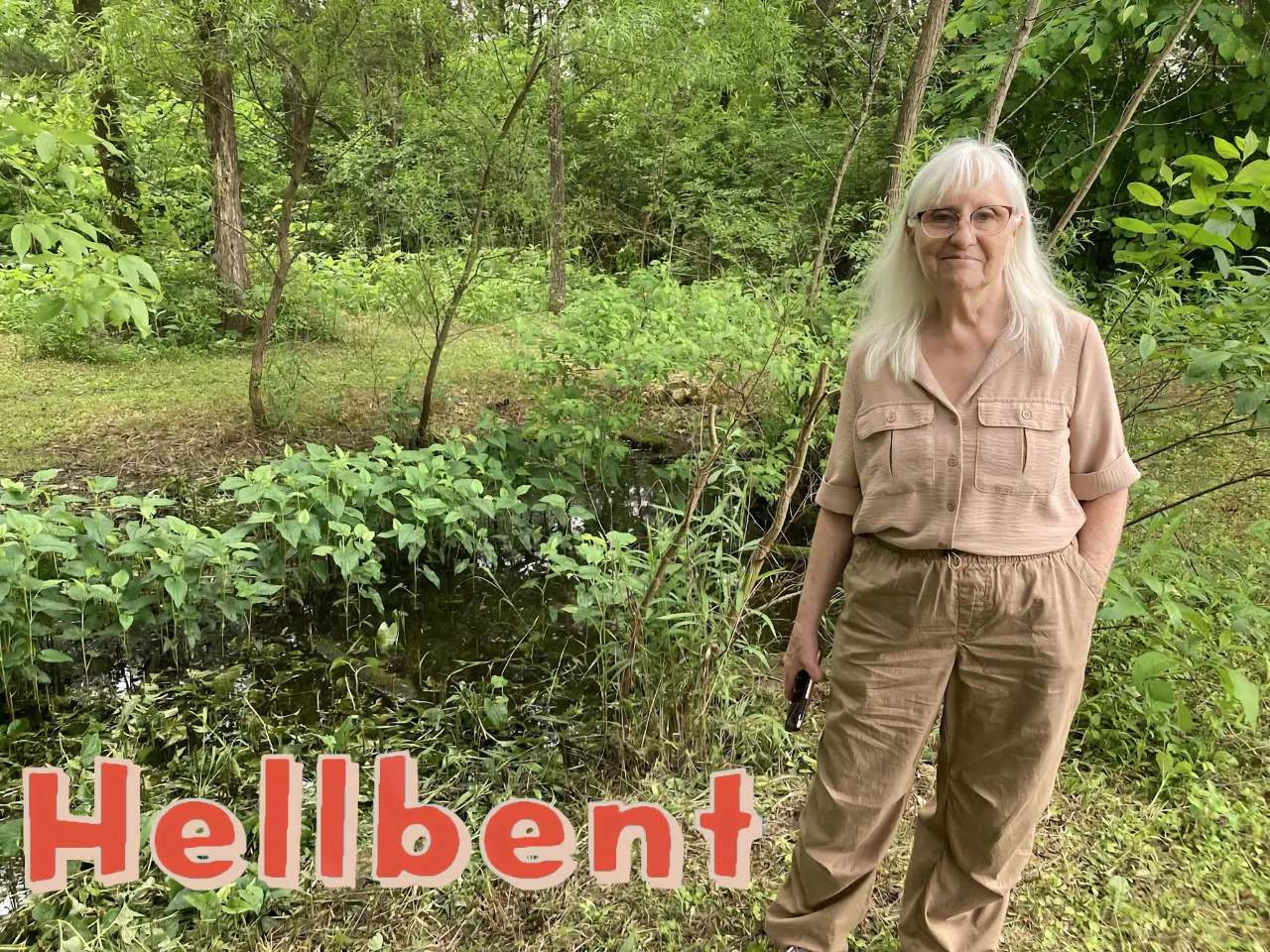 Tennessee Citizens for Wilderness Planning Executive Director Nancy Manning stands in a wetland in the Oak Ridge Cedar Barrens. She is cultivating a project that involves students from nearby Jefferson Middle School. Ben Pounds/Hellbender Press
Tennessee Citizens for Wilderness Planning Executive Director Nancy Manning stands in a wetland in the Oak Ridge Cedar Barrens. She is cultivating a project that involves students from nearby Jefferson Middle School. Ben Pounds/Hellbender Press
New TCWP director already helping our kids ‘Explore and Restore’
OAK RIDGE — The students looked for tiny animals, tested water samples and took careful note of plants. Their recorded observations of Oak Ridge Cedar Barrens, a state natural area, were part of their class at the adjacent Jefferson Middle School (JMS), but volunteers from many outside organizations helped them with their scientific processes. They joined the students on the side of a wetland as they walked through the tall native grasses beneath the red cedars that give the small protected area its name.
Among these volunteers was new Tennessee Citizens for Wilderness Planning Executive Director Nancy Manning. Manning became TCWP’s chief operating agent Aug. 1 of last year, succeeding Sandra Goss after they worked together for a month. Centered in Oak Ridge, TCWP has a storied history preserving and maintaining not just the small Oak Ridge Cedar Barrens area but also Obed Wild and Scenic River and Big South Fork National River and Recreation Area. While Manning is continuing that work, she’s put a special focus on fighting “nature deficit disorder” a term credited to Richard Louv and his book Last Child in the Woods.
The phrase refers to a lack of direct experience with nature, and Louv tied such a deficit in his 2005 book to psychological disorders and obesity. So Manning conceived the “explore and restore” program, which gives students a chance to both study and maintain natural areas, and brought it with her from Texas to Tennessee.
- tcwp
- tennessee citizens for wilderness planning
- nancy manning
- travis audobon
- oak ridge environmental issues
- oak ridge airport
- oak ridge nuclear waste dump
- oak ridge cedar barrens
- obed
- big south fork
- nature deficit disorder
- last child in the woods
- jefferson middle school science
- red cedars east tennessee
- julie mccollough teacher oak ridge
- leonard peltier
- hellbent
Gatlinburg bear faces euthanization following viral social media moment
Written by Thomas Fraser In this image from a social media video, a woman and child are seen outside the Bearskin Lodge in Gatlinburg. Biologists have concluded the bear is too habituated to humans and plans call for trapping and euthanizing the animal. Hellbender Press
In this image from a social media video, a woman and child are seen outside the Bearskin Lodge in Gatlinburg. Biologists have concluded the bear is too habituated to humans and plans call for trapping and euthanizing the animal. Hellbender Press
The incident caught outside a Gatlinburg hotel was not “normal bear behavior” and relocation of a fed, fearless bear isn’t an option
City-based projects are pollinating the planet
Written by Molly McCluskey A parklet in Washington DC with brightly colored planters filled with local pollinator plants. Molly McCluskey
A parklet in Washington DC with brightly colored planters filled with local pollinator plants. Molly McCluskey
From pocket parks to large-scale projects, cities around the world are working to reverse a troubling trend.
This story was originally published by The Revelator.
Every June, cities around the globe celebrate Pollinator Week (this year, June 16-22) an international event to raise awareness about the important roles that birds, bats, bees, butterflies, beetles and other small animals serve in pollinating our food systems and landscapes. These crucial species are declining worldwide, with many on the brink of extinction.
Cities have responded to this crisis with a variety of urban initiatives designed to foster pollinator habitats and in the process transform once-stark cement landscapes — as well as pocket parks, curb strips and highway dividers — into lush, welcoming areas for pollinators and humans alike.
In Washington, D.C., ambitious pollinator projects are abundant on rooftops of public, office and private spaces, ranging from the renovated D.C. Public Library’s main branch to National Public Radio’s headquarters, which hosts an apiary. Throughout the District of Columbia, municipal code requires buildings to maintain the tree boxes and curb strips outside their properties. This often leads to creative landscaping on the smallest of scales.
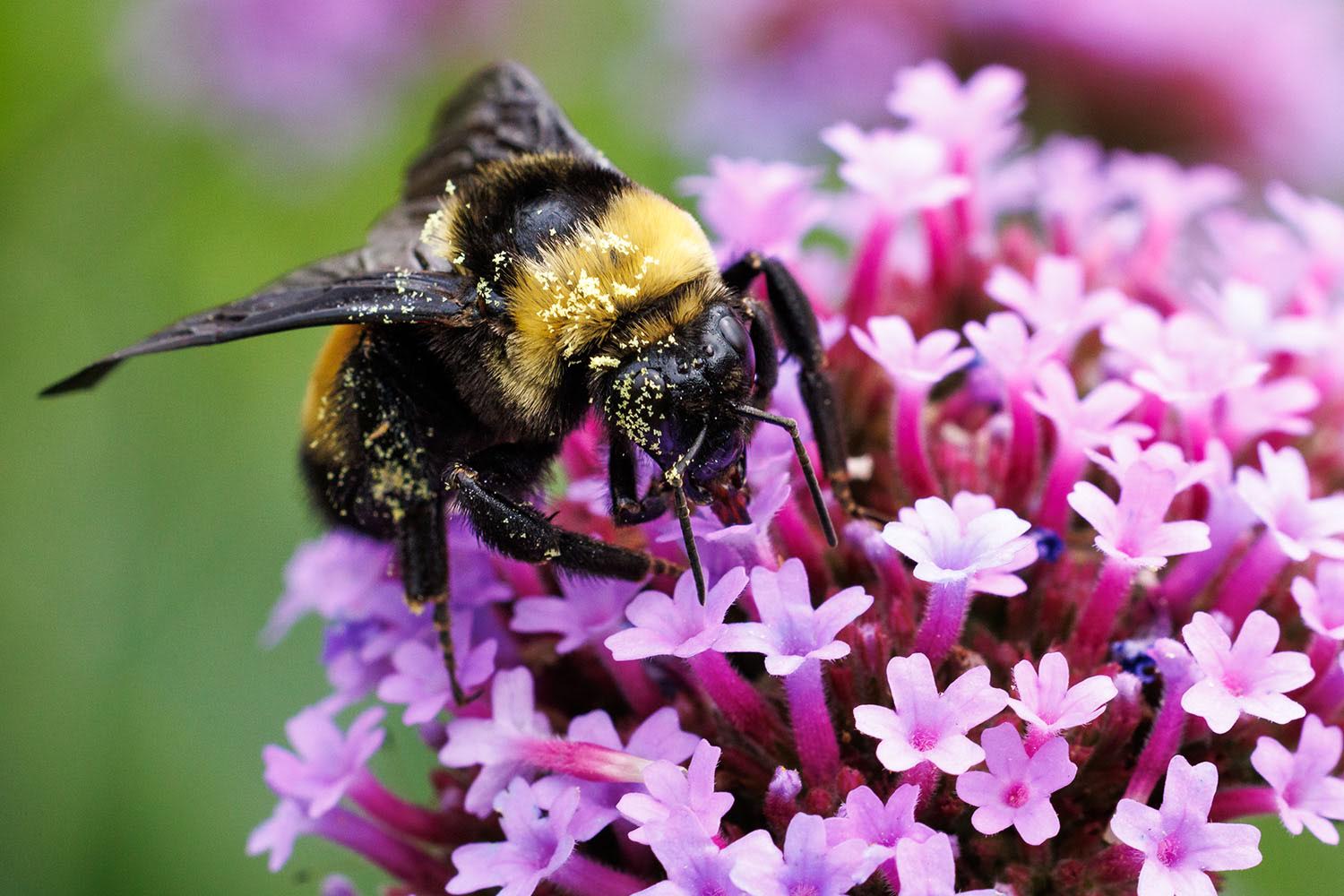 A bumble bee (Bombus sp.) collects pollen from purpletop vervain (Verbena bonariensis) in a pollinator plot on the Tennessee Aquarium plaza in Chattanooga. Tennessee Aquarium
A bumble bee (Bombus sp.) collects pollen from purpletop vervain (Verbena bonariensis) in a pollinator plot on the Tennessee Aquarium plaza in Chattanooga. Tennessee Aquarium
Aquarium celebrates Pollinator Week with activities and giveaways June 17-23
Doug Strickland is a writer for the Tennessee Aquarium.
CHATTANOOGA — Pollinators. They’re kind of a big deal.
From iconic monarch butterflies and humble honey bees to fast-flying hummingbirds and acrobatic ... lemurs?! ... the animals that help plants reproduce are collectively known as “pollinators.” Whether intentional or accidental, the actions of pollen-transporting species contribute tremendously to the health of their respective ecosystems and are responsible for a shocking amount of the food we eat.
The benefits of the human-pollinator relationship are a two-way street. According to the Pollinator Partnership, a nonprofit dedicated to raising awareness about the role pollinators play, pollinators are responsible for roughly one of every three bites of food we eat and propagate over 180,000 different plant species — including more than 1,200 food crops.
All-access passes enabled in Smokies: “This national park belongs to you”
Written by Ben Pounds Vicky Wallace gets assistance crossing a creek in her off-road GRIT wheelchair during an adaptive camping outing along Cooper Road Trail in Great Smoky Mountains National Park. Yvonne Rogers/Hellbender Press
Vicky Wallace gets assistance crossing a creek in her off-road GRIT wheelchair during an adaptive camping outing along Cooper Road Trail in Great Smoky Mountains National Park. Yvonne Rogers/Hellbender Press
Adapted to their environment, wheelchair users venture into Smokies backcountry
TOWNSEND — Four wheelchair users ventured this month to an Abrams Creek backcountry campsite in a first for the Smokies.
Borne by GRIT Freedom Chairs, the able trekkers arrived June 8 in a collaborative event featuring Great Smoky Mountains National Park, Knox County, Kampgrounds of America Foundation and Catalyst Sports. The intrepid group had headed up about a mile of the wide, gravel Cooper Road Trail over hills toward Campsite 1, past horses, along and through streams, finally reaching their campsite. The three-wheeled, arm-powered GRIT chairs are designed for off-road routes.
For much of the route the adaptive hikers used their arms to move their chairs, but other people accompanied them on foot, sometimes helping them up difficult hills or over streams. Those in the chairs enjoyed the mountain water that rushed over their feet.
Park Ranger Katie Corrigan talked about highlights of the natural world around them and led discussions on the concepts of wildness and wilderness. Just like many other backcountry campers, the group of adventurers ate s’mores and slept in tents at the campsite before heading back down Cooper Road to the trailhead the next day.
- carly pearson
- park ranger katie corrigan
- grit freedom chairs
- cooper road trail
- great smoky mountains national park
- abrams creek
- campsite 1 smokies
- kampgrounds of america foundation
- catalyst sports
- daniel penley
- kaitlyn lengel
- vicky wallace
- americans with disabilities act coordinator for knox county
- adaptive sports
- adaptive recreation
- adaptive kayaking
- adaptive recreation smokies
- disabled access
- disabled access to outdoors
- people with disability
- accessibility
- people with limited ability
- adaptive program
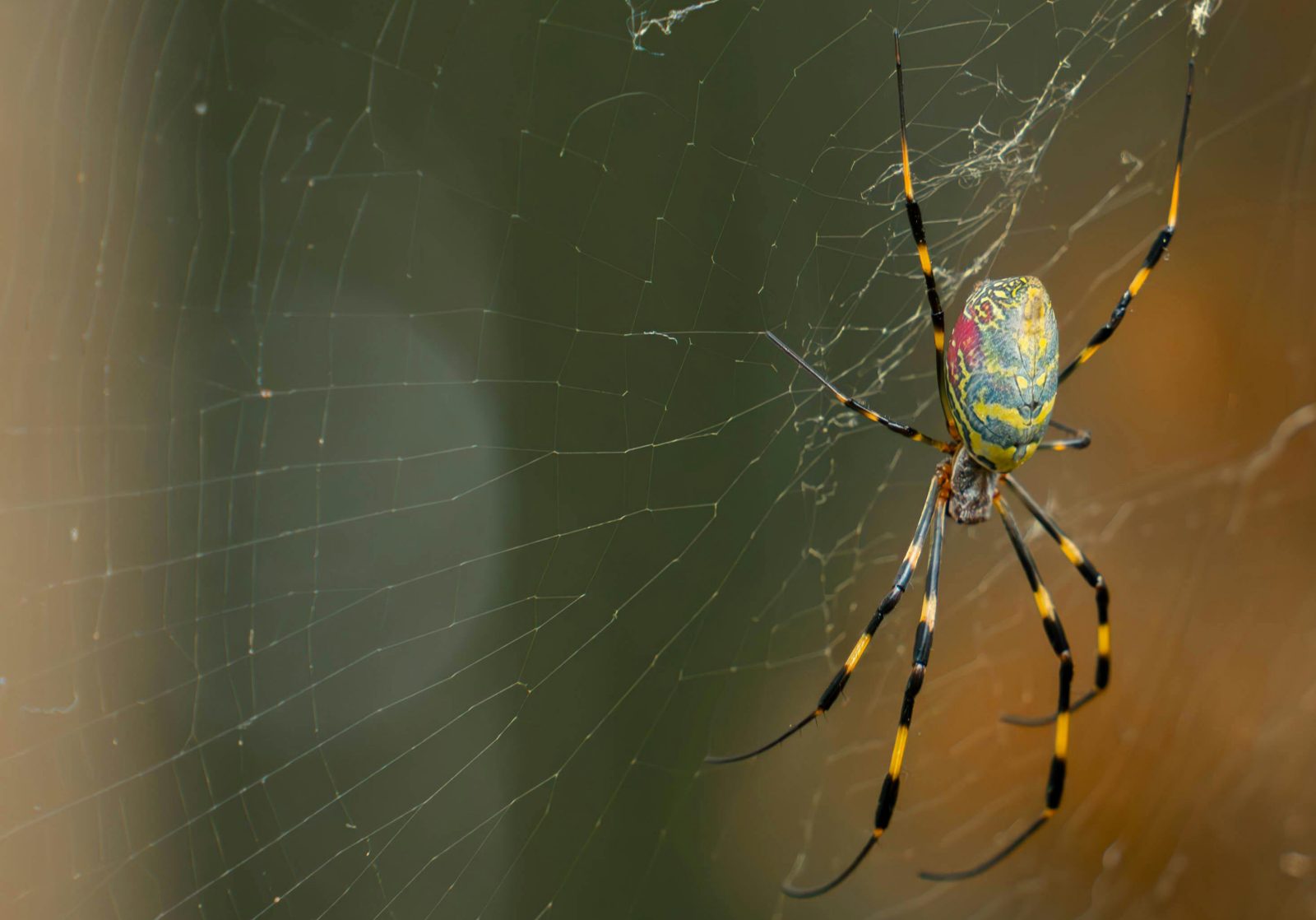 Joro (pronounced “Joe-row”) spiders have made their way to the U.S. from Asia. They may appear intimidating, and can bite like most spiders, but are harmless when left alone. Pexels via Virginia Tech
Joro (pronounced “Joe-row”) spiders have made their way to the U.S. from Asia. They may appear intimidating, and can bite like most spiders, but are harmless when left alone. Pexels via Virginia Tech
Newest invasive exotic spider is harmless, though it doesn’t belong here
Theresa “Tree” Dellinger is a diagnostician at the Insect Identification Lab in the Department of Entomology at Virginia Tech, where she identifies insects and other arthropods and provides management suggestions for insect-related problems. This article was provided by Virginia Tech.
BLACKSBURG — The large, brightly colored Joro spider has been sighted recently on social media in many more places than it has ever been seen in the United States, as exaggerated, misleading stories about the arachnid have gone viral. Yet they pose no threat, except perhaps to insects and to other spiders.
“Joro spiders will likely continue to spread in the U.S., but they aren’t the ‘flying venomous spider invasion’ that’s been sensationalized in the media,” said Virginia Tech entomologist Theresa Dellinger. Answering the questions below, she shared facts about this much maligned spider species.
Q: Where do Joro spiders come from?
“Joro spiders (Trichonephila clavata) are native to east Asia and can be found in Japan, Korea, China, Indochina and Nepal. First reported in northern Georgia in 2014, they are an invasive species of spider that likely entered the U.S. on materials imported from east Asia.”
Judge rules against climate-change denier in UT records suit
Written by JJ Stambaugh This is an excerpt from a 1966 article in Mining Congress Journal indicating mining interests were already aware of the potential for climate change due to carbon dioxide emissions.
This is an excerpt from a 1966 article in Mining Congress Journal indicating mining interests were already aware of the potential for climate change due to carbon dioxide emissions.
Circuit Court ruling: Private emails on public servers don’t always equal public records
KNOXVILLE — A Knox County judge ruled in a lawsuit that spun off from the “Coal Knew, Too” scandal that emails sent or received by a University of Tennessee professor aren’t public records.
Circuit Court Judge William T. Ailor turned aside a bid made by Knoxville-based writer Kathleen Marquardt to review the emails of Chris Cherry, a professor with UT’s Department of Civil and Environmental Engineering, according to court records.
Marquardt filed the Public Records lawsuit four years ago, but the case didn’t actually make it into a courtroom until a pair of hearings held earlier this year.
According to Judge Ailor’s opinion, the bare fact that Cherry and freelance reporter Élan Young (who was also employed by UT at the time and currently writes for Hellbender Press) exchanged emails using their UT accounts “does not raise the emails themselves to the level of being public records.”
The origins of the lawsuit date back to 2019, when Cherry rescued some old coal industry trade journals that a colleague was about to toss in a dumpster after cleaning out an office.
In one of the discarded issues of the Mining Congress Journal was an article from 1966 that contained a statement from the then-president of a coal mining organization explaining that fossil fuel use was causing an increase in atmospheric carbon dioxide that would cause vast changes in the Earth’s climate through global warming.
- coal knew too
- elan young
- huffington post
- climate change
- mining congress journal
- chris cherry
- american policy center
- judge william ailor
- University of Tennessee
- kathleen marquardt
- jj stambaugh
- global warming
- climate change warnings
- climate change coal
- open records act
- public records lawsuit
- public records access
- carbon dioxide emissions
- fossil fuel industry
- fossil fuel global warming
Less carbon, more chill: ORNL tech reduces refrigerator CO2 emissions by 30 percent
 A novel technology developed by ORNL keeps food and beverages refrigerated with an advanced evaporator, phase change materials, metal foam, direct-contact defrosting technology and a low global warming refrigerant. Oak Ridge National Laboratory
A novel technology developed by ORNL keeps food and beverages refrigerated with an advanced evaporator, phase change materials, metal foam, direct-contact defrosting technology and a low global warming refrigerant. Oak Ridge National Laboratory
OAK RIDGE — A technology developed by Oak Ridge National Laboratory keeps food refrigerated with phase-change materials, or PCMs, while reducing carbon emissions by 30 percent.
More than 100 million household refrigerators in operation across the United States consume up to 2 kilowatts of electricity daily. These refrigerators contribute to energy consumption and carbon emissions by using compressors that cycle on and off day and night, pumping refrigerants across evaporator coils to maintain low temperatures for fresh and frozen compartments.
(Hellbender Press previously reported on the development of new coolants and systems at ORNL).
ORNL’s innovation uses advanced evaporators with PCMs installed in each compartment for cold energy storage. PCMs are useful for heating and cooling because they store and release energy when changing from solids to liquids or vice versa. Researchers applied porous metals, direct-contact defrosting technology and a refrigerant with low-global-warming potential to enhance performance and minimize environmental impact.
“PCMs are integrated with evaporator coils to keep temperature constant, requiring one operating cycle and allowing refrigerators to operate almost 100% at nighttime, when energy use is lower,” ORNL’s Zhiming Gao said. “This reduces electricity demand, saves costs and maintains efficiency.”
— Oak Ridge National Laboratory
More...
HBG Program: Cryptocurrencies and Climate Change Casualties
KNOXVILLE — John Nolt, a member of the Sierra Club’s Harvey Broome Group executive committee and professor emeritus in philosophy at the University of Tennessee, will present a program about cryptocurrencies and their detrimental long-term effects on the environment. Cryptocurrency “mines” (data centers, really) pull enormous quantities of power from the electrical grid.
Thus they are attracted to states like Tennessee where electric power is relatively cheap.
The event is set for 7-8:30 p.m. June 11 at the Tennessee Valley Unitarian Universalist Church, 2931 Kingston Pike, Knoxville.
Little River dam-removal project flowing forward, specific timeline TBA
Written by Élan Young Peery’s Mill Dam on the Little River is slated for removal by the Army Corps of Engineers for environmental and public safety reasons. Elan Young/Hellbender Press
Peery’s Mill Dam on the Little River is slated for removal by the Army Corps of Engineers for environmental and public safety reasons. Elan Young/Hellbender Press
Army Corps still committed to Little River dam removal for ecological and safety reasons, but timeline uncertain
TOWNSEND — The remainders of two low-head dams on the Little River in Blount County, Rockford Dam and Peery’s Mill Dam, are slated for removal by the United States Army Corps of Engineers (USACE) following the release in July 2023 of a Project Report and Environmental Assessment that investigated the lower 32 miles of the Little River.
The Corps confirmed this week that plans are moving ahead to remove the two dams.
Peery’s Mill Dam was the site of 4 separate drownings in the last 15 years, giving it the notorious reputation as the deadliest dam in Tennessee in the past quarter century. Late last month, three women had to be rescued from the churning waters there, prompting questions from the community about the status of the Corps’ removal effort.
Little River Watershed Association president Andrew Gunnoe says that watershed advocates are eager for the dam removal project to move forward because doing so would provide both ecological and community benefits.
- peery’s mill
- peery’s mill dam
- little river dams
- little river aqautic life
- little river diversity threat
- little river fatality
- us army corps of engineers
- elan young
- little river
- peery’s mill dam rescues
- why are dams bad for the environment
- rockford dam
- blounty county commission
- dangers of lowhead dams
- elan young journalist
Learn the basics and beauty of freshwater snorkeling at a Conservation Fisheries panel
 Andrew Zimmerman
Andrew Zimmerman
KNOXVILLE — Join Conservation Fisheries, Inc. and other experts for a discussion on how to HEAD UNDERWATER to snorkel and enjoy the beautiful underwater biodiversity of the Southern Appalachians.
The free event is set for 6-8 p.m. June 15 at Remedy Coffee, 800 Tyson Place, Knoxville.
The panel will be led by CFI Director Bo Baxter; Casper Cox from Hidden Rivers of Southern Appalachia; Jennifer Webster from Little River Watershed Association; and TVA Fisheries Biologist Justin Wolbert.
Stripes and spots: A tale of two Southern Appalachian skunks
Written by Matt Dhillon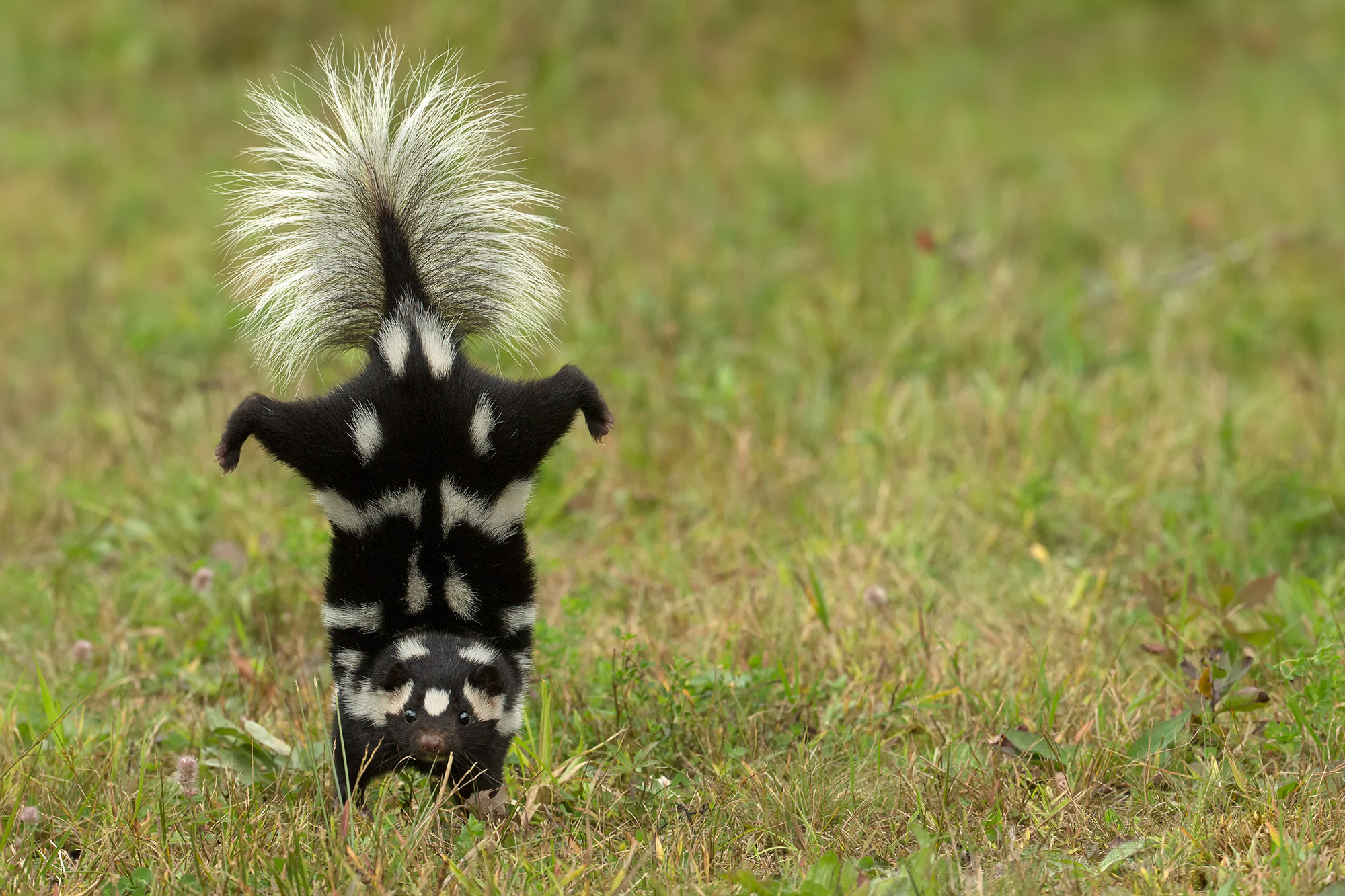 An eastern spotted skunk is seen in its signature defensive handstand. If the stance doesn’t deter predators it will let loose a caustic and malodorous spray akin to mace. Agnieszka Bacal via Virginia Department of Wildlife Resources
An eastern spotted skunk is seen in its signature defensive handstand. If the stance doesn’t deter predators it will let loose a caustic and malodorous spray akin to mace. Agnieszka Bacal via Virginia Department of Wildlife Resources
Striped skunks thrive as spotted cousins decline
This story was originally published by The Appalachian Voice.
BOONE — A characteristic white stripe on a black pelt is an instant warning to tread gently.
Nature’s stink bomb, the striped skunk (Mephitis mephitis) carries this distinctive mark on its back. But Appalachia has a second variety of this master of malodor, marked instead by a blotchy pattern of black and white fur.
The eastern spotted skunk (Spilogale putorius), was not always as rare as it is today. Decades ago, it was relatively common for trappers to catch the polecat, as it’s also known, for its pelt. But spotted skunk populations crashed between 1940 and 1970, according to a landmark paper from the University of Missouri looking at harvest data from trappers. By the 1980s, the study found, harvest numbers had plummeted by 99 percent, reflecting a steep decline in the skunk’s population.
Meanwhile, the spotted skunk’s striped cousin has thrived throughout the United States. So why have their populations diverged so drastically?
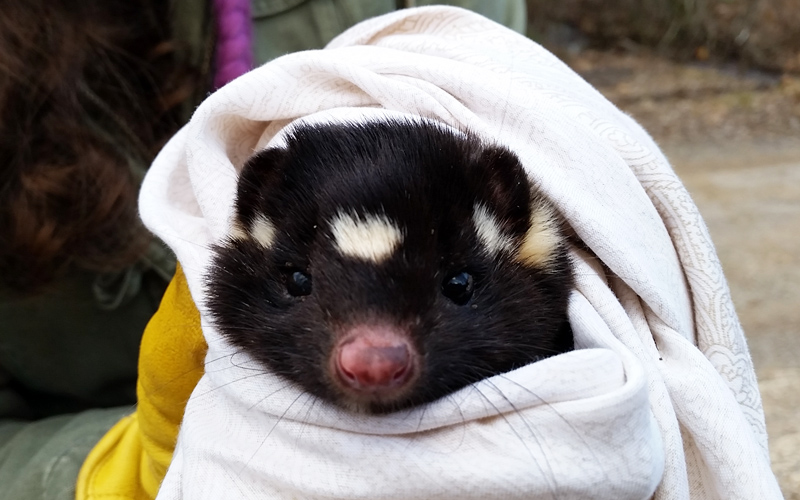 A spotted skunk trapped as part of Emily Thorne’s Virginia Tech study of the animals. Emily Thorne
A spotted skunk trapped as part of Emily Thorne’s Virginia Tech study of the animals. Emily Thorne

